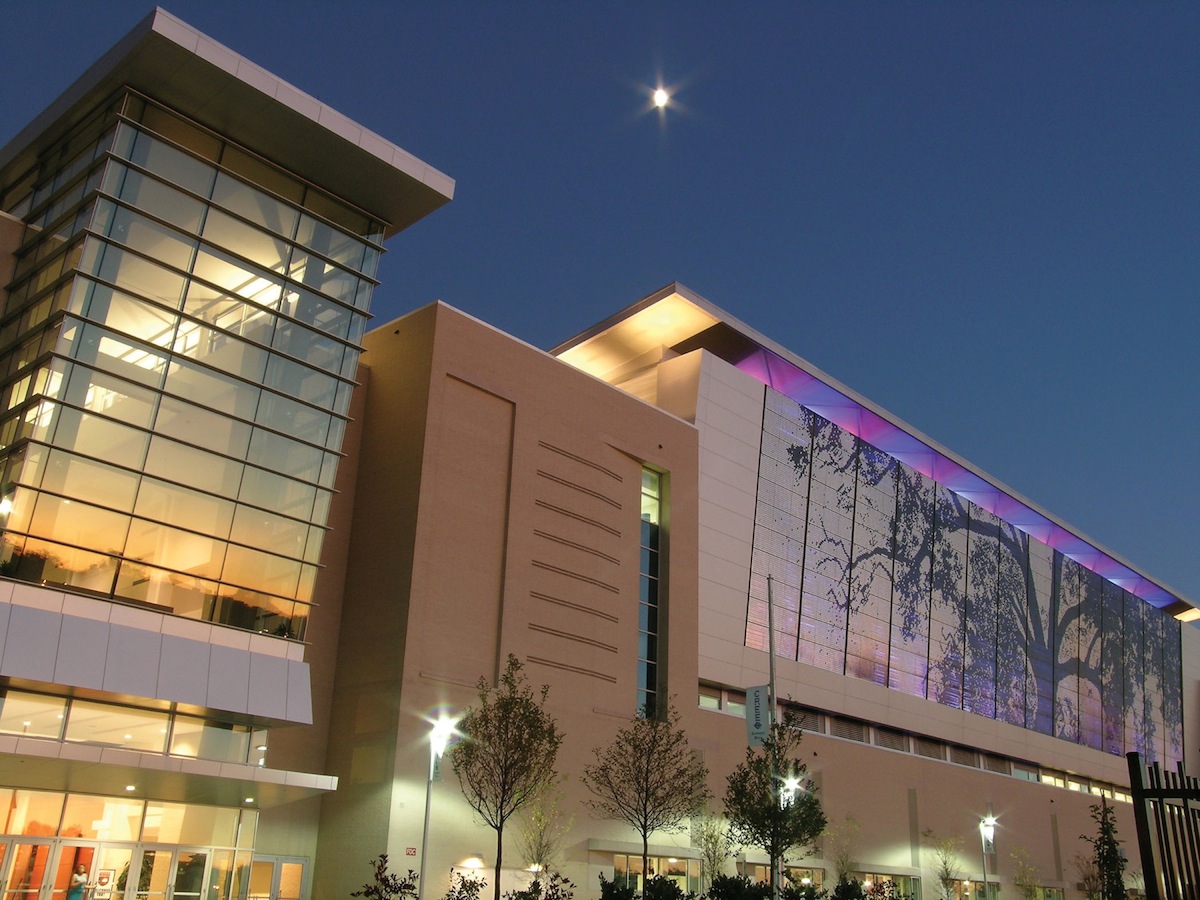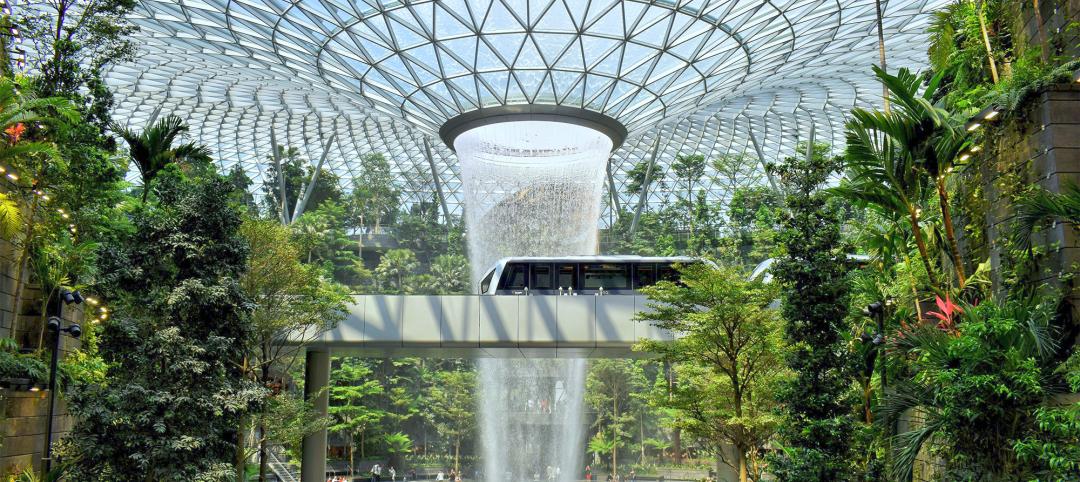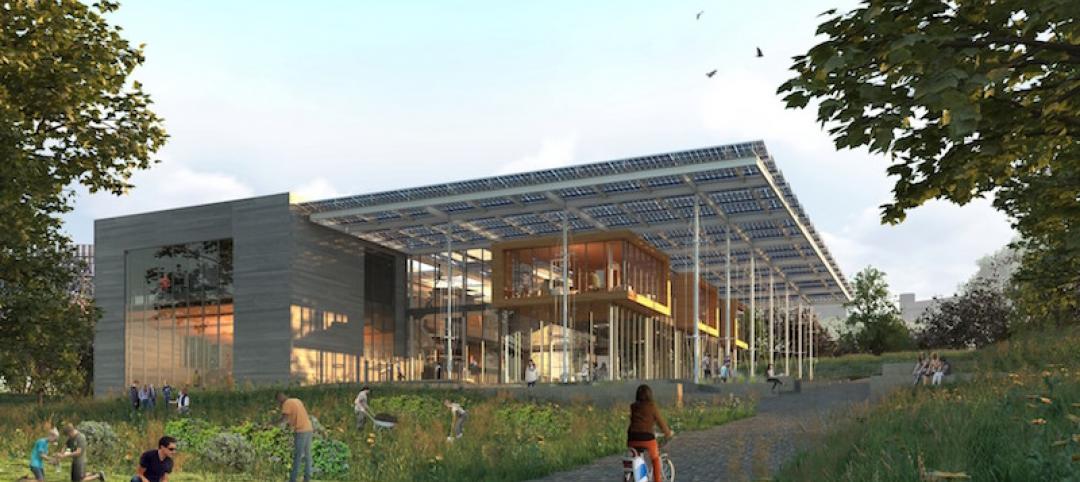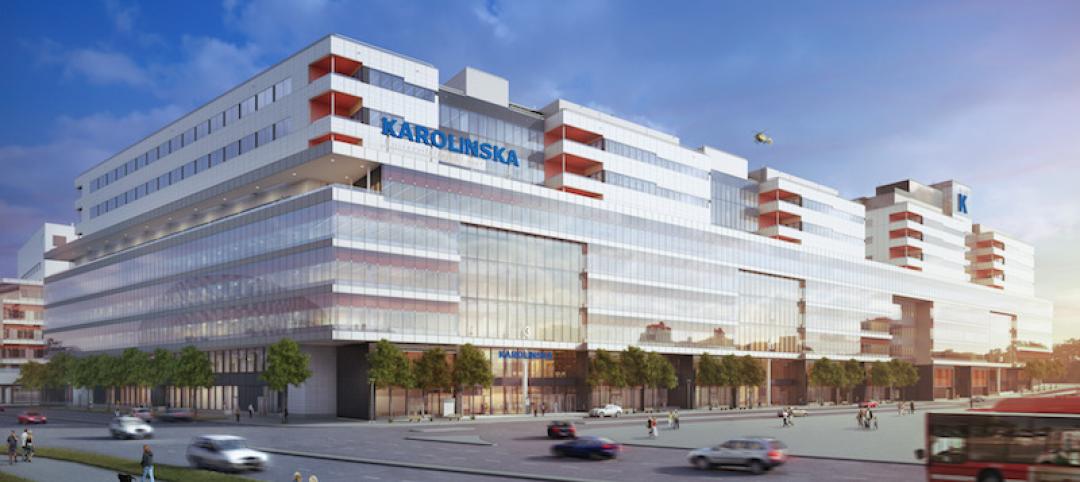In today’s hyper-connected digital world, workers spend their days communicating with their peers via email, text and instant messaging, phone, and video chat. And yet, as productive as many of these digital connections are, the need for personal face-to-face interactions remains incredibly strong.
There are a staggering 1.8 million conventions, conferences, congresses, trade shows, and exhibitions, incentive events, and corporate meetings a year in the U.S., totaling more than 225 million participants, according to the Convention Industry Council. Conventions are even essential in the tech industry, with Google and Microsoft holding some of the biggest events—both Google I/O and Microsoft Ignite just finished up in May.
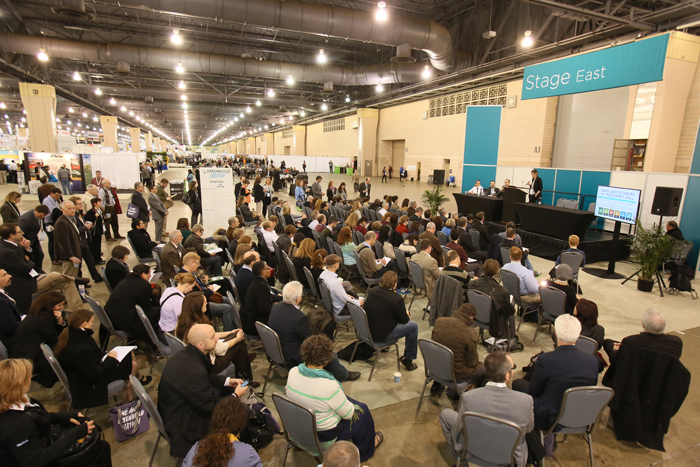 An example of flexible space in a convention center, combining presentations with company displays at Greenbuild.
An example of flexible space in a convention center, combining presentations with company displays at Greenbuild.
To accommodate this demand for meetings in today’s revived economy and a growing need for venues with widely accessible technology, convention centers across the U.S. are expanding and renovating in order to attract more events and be better hosts. The amount of work projected is higher than it has been in five years. Todays’ convention centers require more flexible spaces, the ability to blend virtual and in-person events, and meaningful sustainability. Here is why:
Flexibility: No event is the same, and convention centers are renovating to ensure they can adapt to different types and sizes of meetings. Gardens, outdoor spaces and small theaters are all in demand, along with spaces that can accommodate anything from an intimate group session to a thousand-strong keynote. Consider an event such as Austin’s SXSW, one of the biggest conventions in the world, which hosts everything from panels, to concerts, to movie screenings and huge parties – no cookie cutter presentation spaces there.
What’s more, as events look to bridge the gap between the physical and digital world, spaces need to be flexible enough to accommodate new technology, and there’s increasing demand for spaces that can be used as production studios for video. There is also more demand for highly flexible, unadorned hospitality spaces that can be customized to fit the needs of each event. The Austin Convention Center is looking toward a major expansion of their facility and this type of space is one that they will include. Event producers indicate they want high levels of flexibility and multi-function capability.
"Once thought of as a revenue stream for convention centers, free internet connectivity is an expectation of meeting planners. And while once you could just focus on making sure your exhibition halls were enabled with wireless connectivity, today connectivity is also required for restaurants, outdoor spaces and other social gathering spaces and public plazas."
Building these kinds of spaces – along with long-span ballrooms – requires specialized construction expertise. For example, at our new Raleigh Convention Center project, the exhibit hall, loading dock and services expanded below three adjacent city streets. The building required the construction of three bridges, the excavation of more than 365,000 cubic yards of dirt and the installation of three types of foundation wall systems.
Technology: As with stadium expansions and renovations, convention centers are seamlessly integrating technology. To be ready for everything from live-streaming videos, social media-enhanced presentations, the need for faultless wireless internet and even making sure there are enough charging stations for computers and phones, convention centers are upgrading quickly for today’s increased mobility. This means building advanced infrastructure for Wi-Fi and upgrading distributed antenna systems (DAS) – not easy tasks. Today’s convention goer expects connectivity everywhere.
Once thought of as a revenue stream for convention centers, free internet connectivity is an expectation of meeting planners. And while once you could just focus on making sure your exhibition halls were enabled with wireless connectivity, today connectivity is also required for restaurants, outdoor spaces and other social gathering spaces and public plazas. Technology is the most important new growth area for convention centers according to 42 percent of event producers, based on a report from Red 7 Media Research and Consulting.
Here’s an example of the importance of being ready for technology: the Raleigh Convention Center recently hosted 2,500 members of the North Carolina Technology in Education Society at a recent conference. As people today tend to carry more than one wireless device with them, they brought with them more than 3,200 wireless devices – and a tremendous demand for bandwidth! During an event in the ballroom, a speaker asked all 500 attendees to test a certain web platform simultaneously. Their demand crashed the platform’s web server on the other end, but the convention center’s wireless infrastructure was able to support the load. These kinds of experiences are increasingly the norm, so convention centers must be built and refurbished with connectivity front of mind.
Activity hubs: Much as airports have sought to bring in upscale and local vendors to upgrade the travel experience in the terminal, convention centers are looking to make their facilities stand apart by offering superior and unique amenities. Today’s convention centers are all looking to do more peripheral development – including retail, hotels and supportive infrastructure – within their footprint to capture more revenue.
Red 7 also notes that 54 percent of convention centers have added new revenue streams in 2013. Facilities such as the New Orleans Ernest N. Morial Convention Center have established concessionaire agreements with such vendors as Starbucks, UPS and even spas and other amenities. With Convention Planners booking shorter events, facilities are seeking to maximize the time attendees stay in the building by increasing services. And 60 percent of event producers are supporting that effort by saying they want everything under one roof.
Sustainability: Convention centers are increasingly looking to increase their level of sustainability, for the environmental benefits as well as for reducing operating costs. A few centers are leading the way. For example, the Vancouver Convention Centre boasts a six-acre living roof with thousands of indigenous plants and rainwater recovery for irrigation; seawater heating and cooling; and a fish habitat built into the building foundations. The Pittsburgh Convention Center has achieved LEED Platinum certification.
But increasingly, sustainability stretches well beyond construction. Green operations of these facilities are becoming the norm through the use of environmentally friendly cleaning products and practices. Recycling has expanded to include compostable containers and dinnerware, as well as concession food donations to the needy at the end of every day. Look for more and more convention centers choosing to adapt green features – from living roofs and food composting to LED lighting and highly efficient HVAC systems – over the next few years.
In a world where we increasingly rely on mobile and internet connections, face-to-face meetings are therefore even more significant. Convention centers need to adapt to the technological needs of their audience, while also creating environments that enhance the real-life experiences that cannot be captured online.
About the Author: Tom Tingle is Skanska USA's SVP and National Director of the Sports and Entertainment Center of Excellence.
More from Author
Skanska | Dec 4, 2023
4 key innovations and construction trends across airport design
Here are some of the key trends Skanska is seeing in the aviation sector, from congestion solutions to sustainability.
Skanska | Jun 29, 2023
K-12 school construction: 5 ways strong community relations can lead to success
When constructing a K-12 school, building positive relationships with the community—including students, parents, school staff and residents—is critical to the success of the project. Here are five ways Skanska puts the community first when building K-12 schools in the Pacific Northwest.
Skanska | Mar 14, 2023
Skanska tests robots to keep construction sites clean
What if we could increase consistency and efficiency with housekeeping by automating this process with a robot? Introducing: Spot.
Skanska | Jan 27, 2023
Key takeaways from Autodesk University 2022
Autodesk laid out its long-term vision to drive digital collaboration through cloud-based solutions and emphasized the importance of connecting people, processes and data.
Skanska | Dec 5, 2022
5 ways sustainability professionals can help reduce construction's carbon footprint
Mark Chen, Sustainability Manager at Skanska, has found five specific ways to help the construction industry reduce its carbon footprint.
Skanska | Jul 5, 2022
Tour the new Patricia Reser Center for the Arts in Oregon
This month, the community of Beaverton, Oregon, welcomed a new haven for artistic expression with the opening of Patricia Reser Center for the Arts (The Reser).
Skanska | Jun 22, 2018
What owners should know before choosing the design-build project delivery method
Outside of drawing up a well-written contract, owners often overlook a key attribute that can significantly impact the success of a design-build project, writes Skanska’s Julie Hyson.
Skanska | Dec 7, 2017
Busting the myths: What the “S-word” can mean for construction and development
Sustainability, it’s a trendy term. The problem, however, is that it’s being used in so many different ways that people don’t even know what it means anymore.
Skanska | Aug 15, 2016
Future proofing hospitals
By improving the physical layout of hospitals and medical facilities, we can enhance and increase safety mechanisms, improve care, and help reduce the exposure to medical errors, writes Skanska USA's Andrew Quirk.
Skanska | May 6, 2016
Infographic: The greening of healthcare
By adopting green building and sustainable practices, healthcare facilities can save $15 billion over 10 years. Skanska's infographic spells it all out.

